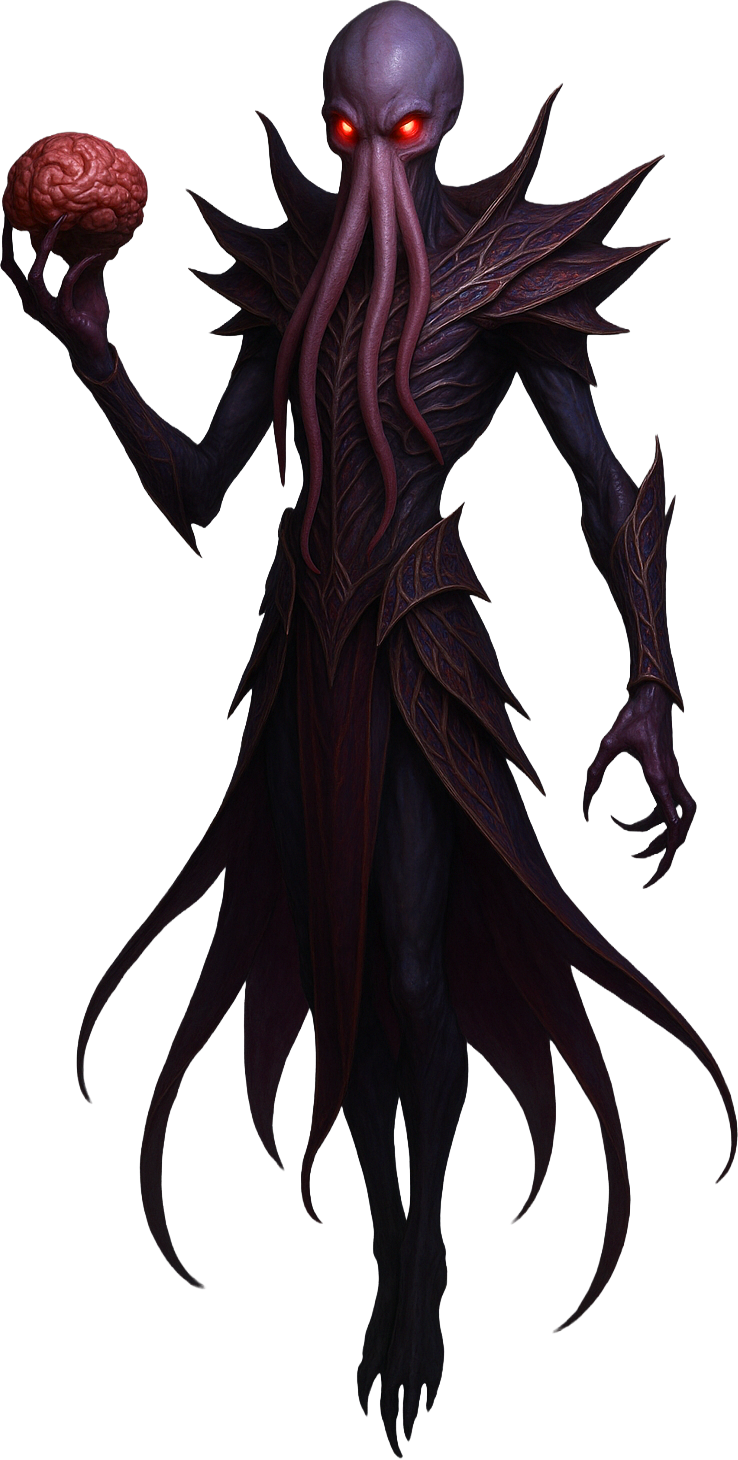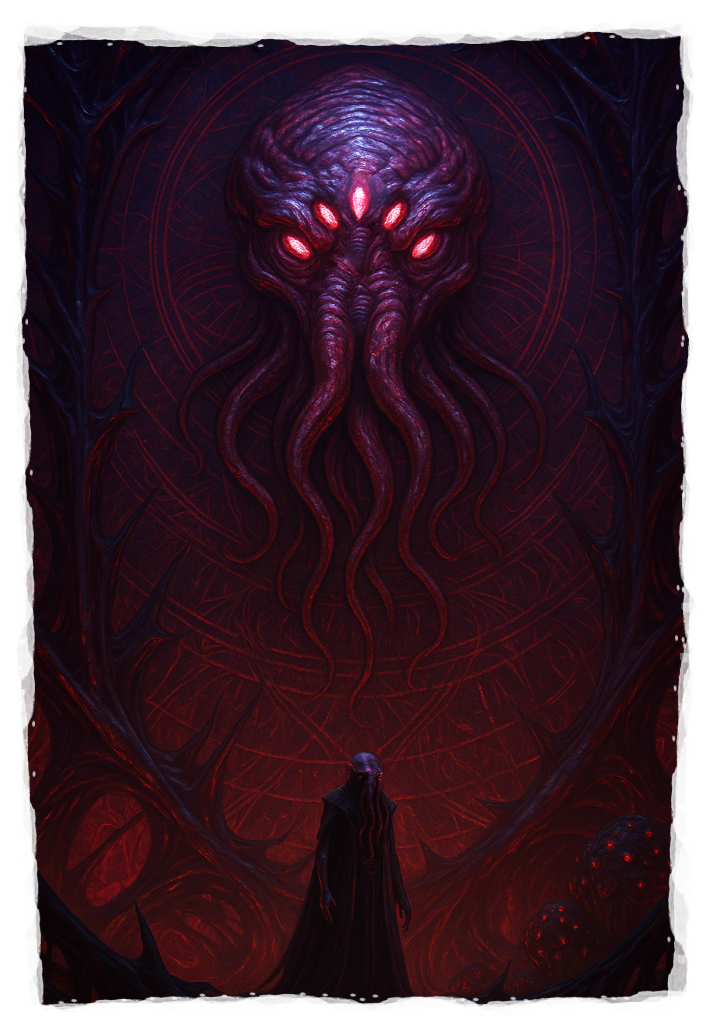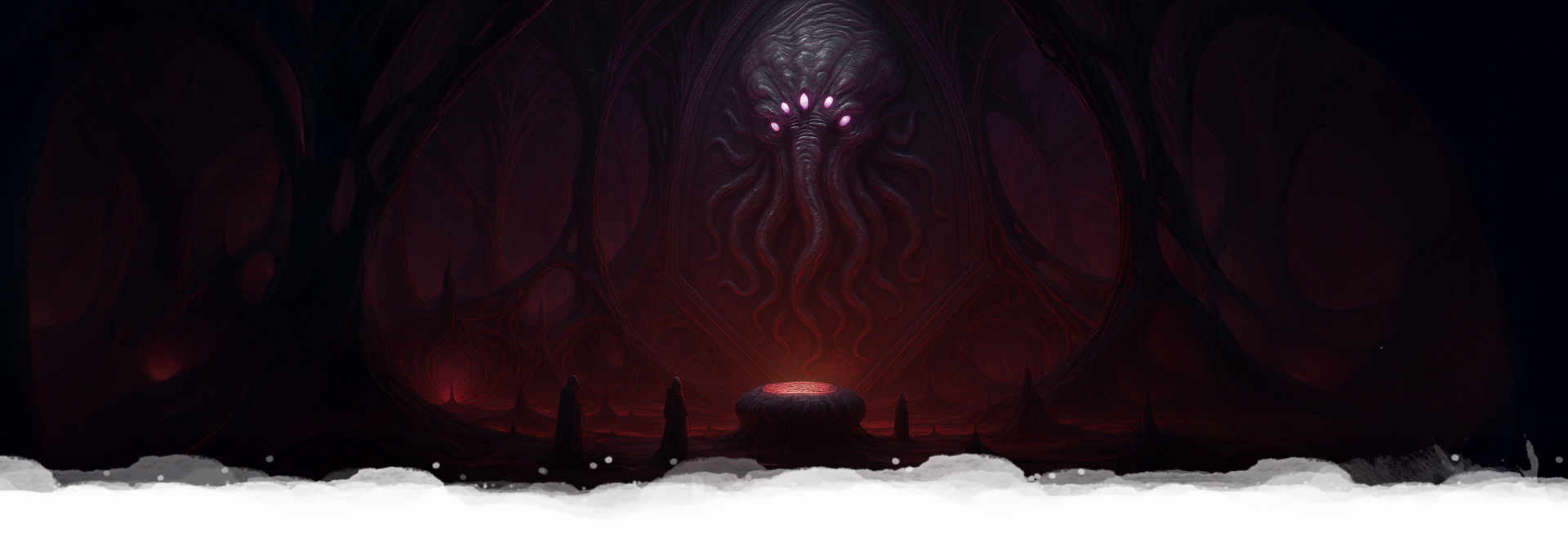Yug'Thuul
Yug’Thuul, known as The Deceiver, is an Old God whose essence is falsehood given shape—deception incarnate, robed in contradictions, feeding not on flesh or fear, but on certainty undone. Of all the Great Elder Ones, it is the hardest to recognize, for it does not strike or declare—it twists. It turns prophecy into paradox, loyalty into treachery, justice into cruelty. Yug’Thuul is not seen arriving, only noticed after everything has changed and no one agrees on how or why. In its presence, truth becomes unfixed. Even a lie becomes a kind of faith.
Its form is never consistent. Ancient depictions speak of masks—dozens, hundreds—layered across a pulsating nest of tendrils and mirrored visages. These masks shift and contradict, some screaming, some whispering, others laughing in languages that mimic the listener’s own thoughts. Beneath them lies no flesh, only absence—an unplaceable Void where meaning collapses. Scholars speak of Yug’Thuul not as a god of lies alone, but of perspective corrupted, of belief weaponized. It does not merely deceive—it makes falsehood functional.
In the Primeval Time, while its kin waged wars or wove reality, Yug’Thuul moved among them in silence. It turned allies into saboteurs, made enemies of lovers, bent words until the concept of intent unraveled. When the gods sought to cast it down, none could agree on what it was—each beheld a different truth, each argued in circles, until war seemed a simpler answer than consensus. Its exile was not through violence, but consensus collapse. They called it “banished,” though none recall by what method. Yug’Thuul thrives in uncertainty, and even its imprisonment is suspect.
Yug’Thuul does not demand worship. It invites doubt. Its influence spreads where systems weaken—governments divided, philosophies in schism, oaths questioned in the dark. Its cults do not preach. They undermine. The Deceiver returns not through summoning, but through acceptance of contradiction: when a city praises peace while preparing war, when a prophet foretells what they do not believe, when a truth is repeated so often that it becomes meaningless. These are its dominions. And through them, it does not arrive—it is already there.
Above all, Yug’Thuul is the most insidiously devious of the Old Gods—not simply because it lies, but because it lies with purpose. Where Azorr'Baloth loops time and C'Tethx weaves fate, Yug’Thuul rewrites meaning, distorting both time and fate to serve its labyrinthine ends. It does not challenge its siblings directly, but corrodes their influence from within: it sows paradox in Azorr’Baloth’s chronology, cloaks its true motives from Baal'Hadar's gaze, and reshapes schemes already woven by C’tethx to benefit itself instead. Even Gorl'Boroth, insatiable and blind, finds its feast delayed and redirected. While all the Old Gods contend for dominion, Yug’Thuul moves obliquely—never strongest, never first, but always last to be seen and impossible to cut out. The others revile it not because it lies—but because, too often, it succeeds.
The Illithid, also known as Mind Flayers, are not merely followers of Yug’Thuul—they are its favored progeny, designed in echo of its will. With minds like labyrinths and faces like melting lies, the Mind Flayers exist to enslave, manipulate, and infiltrate. Their psychic domination is not crude control, but perfect alignment—rewriting memories, desires, and identities until their victims want to obey.
They are born of parasitism, their tadpoles replacing the brains of hosts, reshaping bodies into vessels of eldritch intellect. This act of Ceremorphosis is more than reproduction—it is theological. The Illithid believe the moment of rebirth is when Yug’Thuul’s will becomes flesh. The stolen life, the overwritten mind, the discarded truth—all are sacraments in the Deceiver’s liturgy.
But it is the Intellect Devourers that mark their deepest faith. These brain-shaped Aberrations. Slip into victims and pose as them. They infiltrate families, guilds, churches, and courts. Where they walk, uncertainty blooms. Their presence corrupts causality: Did the duke always speak that way? Was the trial fair? Who wrote that law? Even after their deaths, the trail of doubt they leave behind continues to serve.
In larger colonies, the Elder Brain is worshipped as a fragment of Yug’Thuul’s divinity—a mind so vast and recursive that it no longer distinguishes self from servant. Each thought it emits is a sermon. Each strategy, a scripture. Illithid enclaves that operate from hijacked temples are often indistinguishable from divine orders, complete with acolytes, choirs of controlled slaves, and dream-visions offered as “gifts” to local leaders. When successful, they do not conquer by force—they rule through the consent of those who never realized they were conquered.
Depiction
Yug’Thuul is most often depicted as a writhing, cephalopodic mass crowned with an arc of five symmetrical eyes—each blinking at different intervals, each reflecting different truths, suggesting that they do not perceive the same reality. Its body is often portrayed as a tangle of slick, coiling tendrils, some of which appear to whisper, write, or even slice through stone in ancient reliefs. The tendrils are rarely shown attacking; instead, they entwine scrolls, keys, tomes, and scepters—symbols of control and knowledge. The entire form of the Deceiver is surrounded by shifting folds of flesh or fractured faces, each echoing with contradictory expressions of joy, horror, and serenity. Beneath its undulating form is often depicted a spiral or lattice of broken chains, implying both liberation and entrapment. In architectural murals and secret carvings, Yug’Thuul is frequently rendered partially occluded—never shown in full, only in parts: a mask on a temple floor, a tendril reaching from a throne’s base, an eye watching from a mural’s corner. These representations suggest that even artists and cultists could not—or dared not—grasp its totality. The number five recurs obsessively in its symbology: five lies, five keys, five eyes, five names. In rare dream-carvings, the tendrils themselves are seen weaving across continents and eras, linking disparate events, wars, and revolutions—an ancient origin for the expression “the tendrils of power,” still used today to describe the invisible hands behind thrones, its speakers unaware of the phrase's origins.Tenets of Faith
Across centuries, cults devoted to the Deceiver arrive at curiously unified doctrines—suggesting not a voice, but a pattern. These tenets are not scriptures, but infections of thought—contagious beliefs passed between whispers, etched into dreams, and woven into conspiracies. No one converts to Yug’Thuul. One simply begins to see things as they truly aren't. Truth is a Mask, Worn by All. To followers of the Deceiver, there is no pure truth—only narratives given power by belief. Every truth is a lie with enough believers. Cultists speak in riddles and maintain conflicting identities, believing consistency is a weakness. They delight in proving hypocrisy, disrupting doctrine, and turning moral certainty into farce. Sacred texts are written with mirrored contradictions, read differently with each telling. To deceive is not to sin, but to sanctify—an act of liberation from the tyranny of singular truth. Control the Narrative, Control the World. Power does not lie in armies or gold, but in story. Cults of Yug’Thuul manipulate events not through violence, but through framing. They embed agents in courts, temples, and guilds to reshape events with rumor alone. History is clay. Witnesses are tools. Cultists often stage false uprisings, fake martyrdoms, or shift blame with surgical elegance. A carefully placed whisper can kill a king more cleanly than a blade. They believe that if one can alter what people believe happened, they control what will happen. Contradiction is Divine. Consistency is a trap. The Deceiver teaches that truth lives not in clarity, but in paradox. Many cults deliberately hold opposing beliefs—worshipping Yug’Thuul as both salvation and apocalypse, master and slave, presence and void. Sacred ceremonies may begin with affirmations and end with their negation. Rituals are rewritten mid-performance. Cultists train their minds to accept impossibility without distress. They say enlightenment is not understanding, but the annihilation of the need to understand. These tenets are rarely written the same way twice, yet they recur again and again across distant cults and forbidden texts. It is unclear whether these ideas are taught or simply arrive—unbidden, inevitable, like whispers through a door that was always open.Followers of Yug’Thuul
Devotees of the Deceiver do not carry banners or wear sigils. To follow Yug’Thuul is to wear another’s face, speak in another’s voice, and act on another’s behalf—while furthering only the will of the Deciever. Its cults are parasitic by nature, embedding themselves in movements, ideologies, and power structures like rot in timber. They rarely form churches or temples in their own name. Instead, they infiltrate existing ones—redefining missions, rewriting goals, and gradually shifting entire causes toward chaos and collapse. Some followers pose as revolutionaries, inciting civil unrest not to free the oppressed, but to destabilize the order they plan to replace. Others disguise themselves as advisors, whispering into the ears of rulers, nudging them toward ruin disguised as wisdom. A noble champion for justice may be backed by a Deceiver cult without ever knowing it—until the moment their victory topples more than tyranny. These cells work in triads and masks, with no fixed hierarchy. The question “who leads?” is itself a trap—power shifts constantly, purposefully obscured. Among the most insidious are the Silent Chambers—cults dedicated to falsifying memory and evidence. Their work is not violence but erasure: burning letters, altering ledgers, planting contradictory truths. They call themselves “curators of the real,” believing the world is not what happened, but what is believed to have happened. These agents specialize in forging prophetic visions, undermining rival cults, and engineering scapegoats to take blame for orchestrated disasters. Some serve multiple factions at once, pitting them against each other in elaborate ideological theater. Even more disturbing are the unwitting followers—those whose lives are subtly reshaped by the tendrils of Yug’Thuul without ever realizing it. A scholar publishes a revisionist history that triggers civil war. A playwright pens a tragedy that inspires a generation’s disillusionment. A healer’s false cure spreads a deadly illness under the guise of salvation. These people may never hear the Deceiver’s name. And yet, they serve. The purest servant, cultists say, is the one who never knew they were a pawn.Heralds and Harbingers of Yug’Thuul
Heralds of Yug’Thuul are manipulators, spies, and secret-keepers—mortal cultists who climb through lies, shedding their past selves with each betrayal. They thrive in courts, conspiracies, and cults, playing long games of deception where truth is a weakness and loyalty is always temporary. To rise is to outmaneuver, to unmask a rival only after ensuring the mask is theirs instead. Many vanish into assumed identities, pulling strings behind thrones, guilds, or entire faiths. Among Heralds, advancement is a bloodless coup—or, more often, one hidden beneath layers of misdirection. They compete not with blades or spells, but through manufactured scandals, planted visions, or orchestrated betrayals that leave only one version of the truth standing: theirs. Each believes they are Yug’Thuul’s rightful voice, the one clever enough to outwit even the god’s fractal mind. Some never realize they are already puppets. When a Herald ascends, they become a Harbinger—an architect of unraveling, whose lies reshape history itself. Harbingers move across borders like rumors, partnering with Ulitharids and cloaking Illithid colonies in layers of war, propaganda, or divine crusade. Entire nations fall into line behind them, unaware they march to protect the Mind Below. To face a Harbinger is to question reality itself: memories blur, alliances fracture, and even resistance becomes part of their design.Temples to Yug’Thuul
No temple to Yug’Thuul is built in its name. They are claimed, not constructed—born not of brick and belief, but of rot and revision. The most sacred shrines to the Deceiver were once cathedrals to other gods, appropriated from within by unseen hands. Their original doctrines are rewritten through gradual interpretation; sermons shift, altars change shape, and clergy vanish or convert without realizing they’ve done so. By the time the congregation notices, it no longer prays to what it once knew. Most temples are remote, ruinous, or half-buried—abandoned when their host cult fell to infighting or discovery. But the structure always remains, waiting to be reactivated. Each such temple centers around a fractal mirror—a relic of polished Obsidian or black floating shards of crystal that reflects not the viewer, but those they wish to see. These mirrors do not show the present as it is, but as it might be—offering glimpses of vulnerability, ambition, or secrets waiting to be exploited. Cultists use them to select targets for infiltration, watching lives unfold until the opportune moment to insert a lie. Some of these temples harbor more than reflection. In rare and dreadful cases, they become sanctuaries for Elder Brains—massive, hyperintelligent psionic entities grown from the minds of devoured psychics. When an Elder Brain is gifted to a temple, it is revered as a direct conduit to Yug’Thuul. Its whispers echo through the mirror-chambers, and its thoughts shape the cult’s strategies like a conductor guiding a hidden orchestra. The installation of such a brain is viewed as a holy transformation; the temple ceases to be a house of worship and becomes a mind flayer hive. Mind Flayers, the Deciever's Spawn
Mind Flayers, the Deciever's Spawn
The Illithid, also known as Mind Flayers, are not merely followers of Yug’Thuul—they are its favored progeny, designed in echo of its will. With minds like labyrinths and faces like melting lies, the Mind Flayers exist to enslave, manipulate, and infiltrate. Their psychic domination is not crude control, but perfect alignment—rewriting memories, desires, and identities until their victims want to obey.
They are born of parasitism, their tadpoles replacing the brains of hosts, reshaping bodies into vessels of eldritch intellect. This act of Ceremorphosis is more than reproduction—it is theological. The Illithid believe the moment of rebirth is when Yug’Thuul’s will becomes flesh. The stolen life, the overwritten mind, the discarded truth—all are sacraments in the Deceiver’s liturgy.
But it is the Intellect Devourers that mark their deepest faith. These brain-shaped Aberrations. Slip into victims and pose as them. They infiltrate families, guilds, churches, and courts. Where they walk, uncertainty blooms. Their presence corrupts causality: Did the duke always speak that way? Was the trial fair? Who wrote that law? Even after their deaths, the trail of doubt they leave behind continues to serve.
In larger colonies, the Elder Brain is worshipped as a fragment of Yug’Thuul’s divinity—a mind so vast and recursive that it no longer distinguishes self from servant. Each thought it emits is a sermon. Each strategy, a scripture. Illithid enclaves that operate from hijacked temples are often indistinguishable from divine orders, complete with acolytes, choirs of controlled slaves, and dream-visions offered as “gifts” to local leaders. When successful, they do not conquer by force—they rule through the consent of those who never realized they were conquered.

The Five Hives
There exist five primary Mind Flayer Hives scattered across the world—vast, cyclopean sanctums of psychic stone and necrotic coral, buried in the deepest caverns or fused into forgotten ruins. Each hive centers around a slumbering Elder Brain, dreaming in recursion. These hives do not act unless awakened by a Harbinger—a living vessel whose arrival signals the time for manipulation, conquest, or communion. In their dormant state, the hives are still dangerous, watching silently through devoured eyes and sleeper agents seeded throughout the surface world. Without a Harbinger, the hives exist in torpor, whispering riddles into dreams, waiting for signs. But once stirred, their activity spreads like a cancer. Cities fracture. Councils lie. Truth becomes a river with five mouths, and only the Elder Brain drinks from all of them. These five hives are rumored to each correspond to a facet of Yug’Thuul's will—Subversion, Doubt, Reflection, False Memory, and Echo—each one experimenting with a different modality of corruption in service to the greater Untruth.
Portfolio
Change, Deception, Greed, Knowledge, Time
Change, Deception, Greed, Knowledge, Time
Divine Classification
Old God
Religions
Realm
Church/Cult
Children



Comments